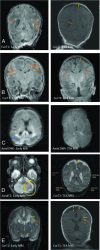White Matter Injury on Early-versus-Term-Equivalent Age Brain MRI in Infants Born Preterm
- PMID: 38216303
- PMCID: PMC11285978
- DOI: 10.3174/ajnr.A8105
White Matter Injury on Early-versus-Term-Equivalent Age Brain MRI in Infants Born Preterm
Abstract
Background and purpose: White matter injury in infants born preterm is associated with adverse neurodevelopmental outcomes, depending on the extent and location. White matter injury can be visualized with MR imaging in the initial weeks following preterm birth but is more commonly defined at term-equivalent-age MR imaging. Our aim was to see how white matter injury detection in MR imaging compares between the 2 time points.
Materials and methods: This study compared white matter injury on early brain MR imaging (30-34 weeks' postmenstrual age) with white matter injury assessment at term-equivalent (37-42 weeks) MR imaging, using 2 previously published and standardized scoring systems, in a cohort of 30 preterm infants born at <33 weeks' gestational age.
Results: There was a strong association between the systematic assessments of white matter injury at the 2 time points (P = .007) and the global injury severity (P < .001).
Conclusions: Although the optimal timing to undertake neuroimaging in the preterm infant remains to be determined, both early (30-34 weeks) and term-equivalent MR imaging provide valuable information on white matter injury and the risk of associated sequelae.
© 2024 by American Journal of Neuroradiology.
Figures


Comment in
-
On Behalf of Serial Imaging in Preterm Infants.AJNR Am J Neuroradiol. 2024 Jun 7;45(6):E16. doi: 10.3174/ajnr.A8223. AJNR Am J Neuroradiol. 2024. PMID: 38782591 Free PMC article. No abstract available.
References
-
- de Bruïne FT, van Wezel-Meijler G. Radiological assessment of white matter injury in very preterm infants. Imaging Med 2012;4:541–50 10.2217/iim.12.37 - DOI
MeSH terms
LinkOut - more resources
Full Text Sources
